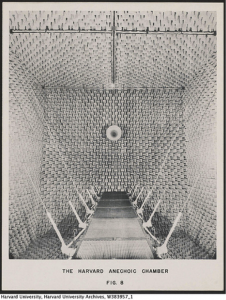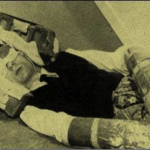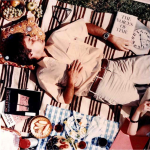Beranek’s Box
image: The Harvard Anechoic Chamber
Courtesy of Harvard University Archives
Harvard’s Anechoic Chamber and the Silence of John Cage
Built in 1943 and dismantled in 1971, Harvard’s echoless room famously inspired John Cage’s work 4’33”. In his 1958 lecture in Brussels, “Indeterminacy,” Cage describes the now-mythic experience:
“It was after I got to Boston that I went into the anechoic chamber at Harvard University. Anybody who knows me knows this story. I am constantly telling it. Anyway, in that silent room, I heard two sounds, one high and one low. Afterward I asked the engineer in charge why, if the room was so silent, I had heard two sounds. He said, “Describe them.” I did. He said, “The high one was your nervous system in operation. The low one was your blood in circulation.” (8)
The room was designed and built by Dr. Leo Beranek, Director of Harvard’s Electro-Acoustic Laboratory during WWII, and later, Professor and Technical Director of Electro-Acoustics at MIT before starting his own acoustical consulting firm. According to Beranek, his chamber (often referred to as “Beranek’s Box”) was the first to be built in North America. Harvard’s acoustics research was initiated by the American National Defense Research Committee in 1940 to investigate sound in combat vehicles. Their objective was to design systems and technologies to improve communication and noise control in wartime situations. The chamber was devised as an enclosure to test loudspeakers used on beach landings, for broadcasting instructions to troops.
Through his research, he and his graduate student Harvey Sleeper discovered that a particular cone-shaped wedge made out of fiberglass worked best to create an echo-free room. In a 1989 interview, Beranek recalls that they then received $350,000 to erect a concrete building and fill a 50 ft room with “seven railway carloads of fiberglass, made into these wedges.” Beranek claims that, while Bell Labs — sometimes credited with the first anechoic room — had built a structure to house their chamber, it wasn’t lined with any materials until after the war, when his wedge fiberglass designs were used in its construction.
In the early 70s, the US government offered to tear-down anything they had constructed during the war for free. Harvard decided that it wasn’t going to continue with any research on acoustics after the department’s founder, Dr. F. V. Hunt (who developed the first lightweight phonograph pick-up stylus) had died, so they gave the go-ahead and the anechoic chamber was destroyed.
Beranek went on to perform commercial work, including inventing the “Hush-a-Phone” device (for silencing telephone conversations) which led to a chain of regulatory challenges that eventually broke up the Bell Telephone monopoly in the 1980s. He was also instrumental in assembling the group of academics and researchers involved in developing ARPANET (the proto-internet).
Inside the four-storey concrete “box,” the 20,000 wedges of fiberglass fracture and absorb sounds since they are composed of sizes smaller than audible wave forms. The chamber had loudspeakers installed, special lighting and a walkway platform suspended with steel cables above the soundproofed floor.
After Cage visited the chamber in 1951, he composed his work 4’33”— his four and a half minute composition consisting of “silence,” ambient sounds rather than musical performance — the following year. Theorist Douglas Kahn writes that both the chamber and 4’33” worked to shift focus:
“4’33” muted the performer to shift attention to the sounds in the surrounding space and by implication to environmental sounds in general, while the anechoic chamber muted the sounds of the surrounding space, cordoning off all environmental sounds and dampening sounds inside its waffled walls to shift attention to Cage’s internal bodily sounds and by implication to the impossibility of silence and the pervasiveness of music.” (191)
The experience shifted Cage’s work in other ways — he began to use electronic technologies including microphones and amplification devices, and later, radio. His work 0’00” from 1962 sought to amplify bodily actions, it was “nothing but the continuation of one’s daily work, whatever it is… done with contact microphones, without any notion of concert or theatre or the public, but simply continuing one’s daily work, now coming out through loudspeakers.” Through his focus on all sounds, micro- and macroscopic, he sought to shift the mid-twentieth century focus on visuality to an aural, and musical, culture.
Dana Samuel, PhD Candidate, Humanities Doctoral Program, Concordia University
References
Beranek, Leo. Riding the Waves: A Life in Sound, Science and Industry. Cambridge: MIT Press, 2008. Print.
Beranek, Leo. “Interview of Leo Beranek by Jack Purcell on February 26, 1989.” Niels Bohr Library & Archives, American Institute of Physics, 2012. Web.
Oral History Transcript: Dr. Leo Beranek
Beranek, Leo and Harvey P. Sleeper, Jr., “The Design and Construction of Anechoic Sound Chambers,” Journal of the Acoustical Society of America 18 (1946): 140-150.
The Design and Construction of Anechoic Sound Chambers
Cage, John. “Experimental Music.” Silence: Lectures and Writings. Middletown, Conn.: Wesleyan University Press, 1961. 8. Print.
Cage, John and David Tudor. Indeterminacy: New Aspect of Form in Instrumental and Electronic Music and Ninety Stories by John Cage, with Music. Smithsonian/Folkways, 1959/1992. Audio recording.
Department of the History of Science. “The Collection of Historical Scientific Instruments at Harvard University.” Harvard University Archives. Harvard University, 2012. Web. The Collection of Historical Scientific Instruments at Harvard University
“Eerie Echoless Room Torn Down with Lab.” The Harvard Crimson. Harvard University, March 30, 1971. Web. Eerie Echoless Room Torn Down With Lab
Kahn, Douglas. “John Cage: Silence and Silencing.” Noise Water Meat: A History of Sound in the Arts. Cambridge: MIT Press, 2001. 161-199. Print.


